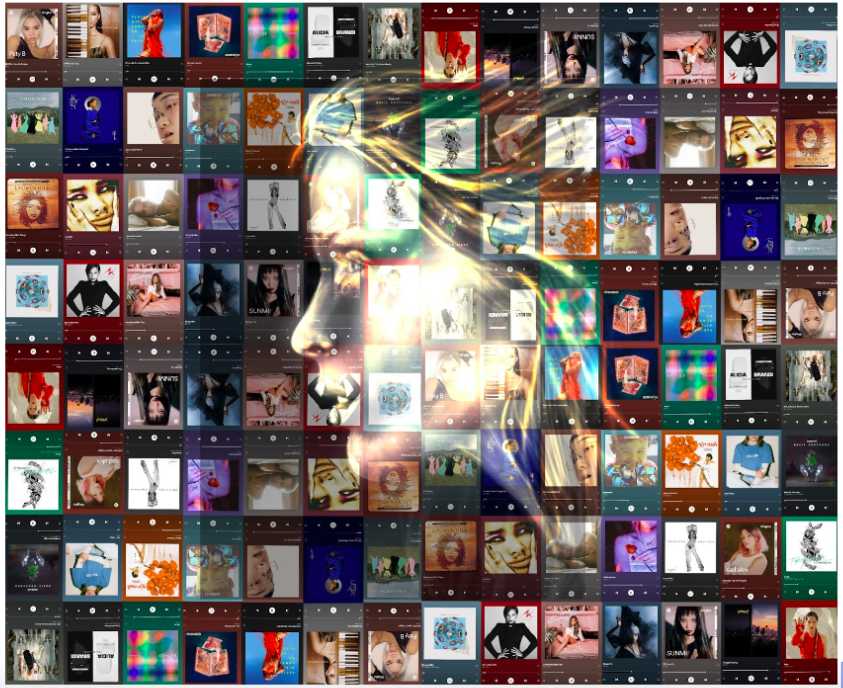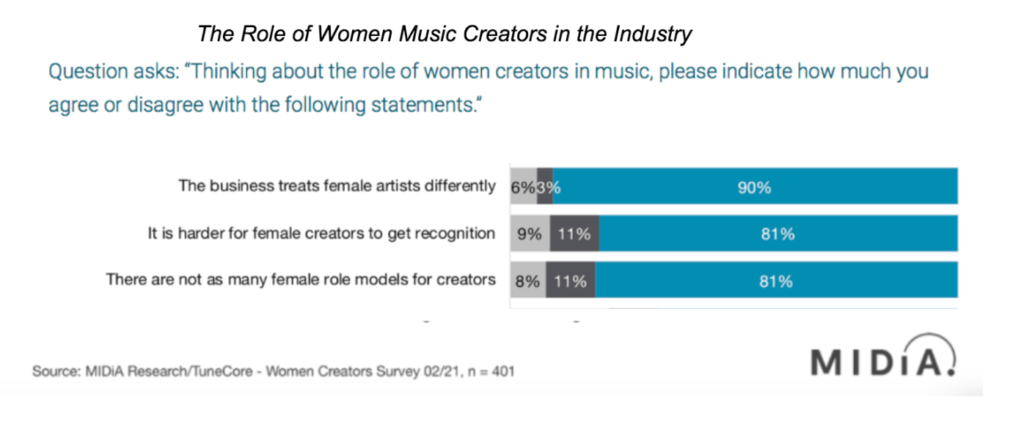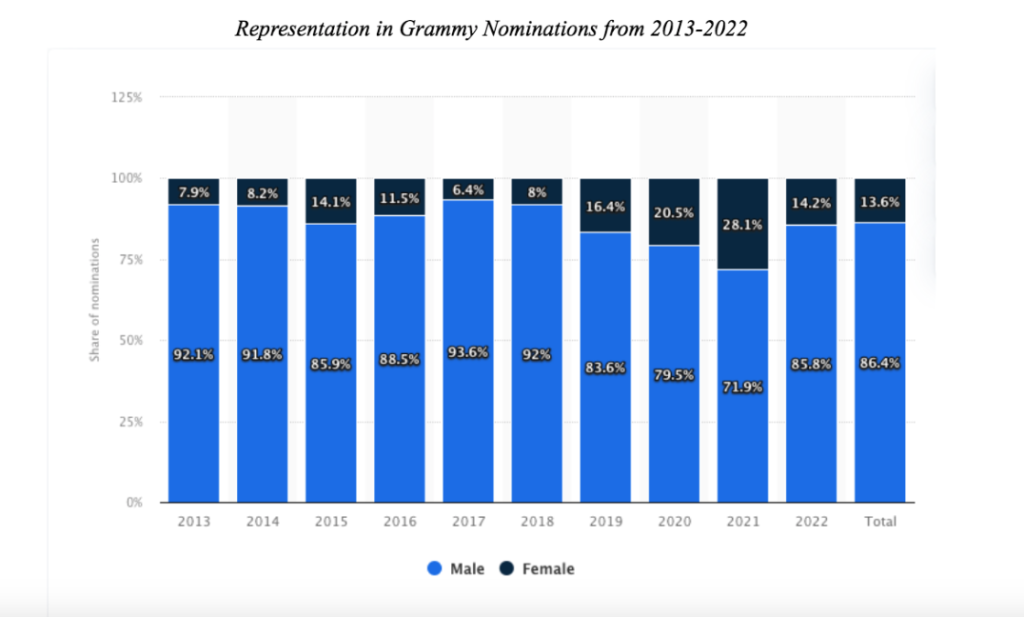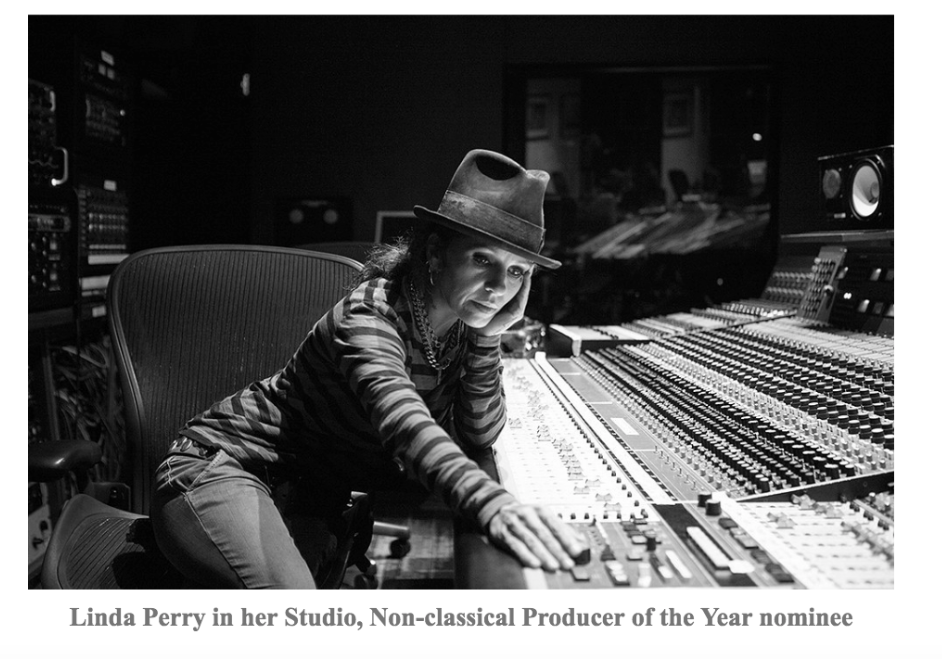
An immense amount of work goes into a song’s final product. Record labels and talented artists depend on producers to help them develop and make their music sounds its best (George, 2016). Without them, listeners wouldn’t be able to experience the emotionally engaging songs that are loved and praised so much. However, nearly every song streamed is produced by a man. Among the rankings of the 50 best music producers of the 21st century, only ~3 are women.
Roughly 97% of music producers identify as men, and only 2.8% identify as female or non-binary people.
(Götting, 2022)
Why is it harder for female producers to become successful in the music industry?
The role of music producers has historically been positioned as men (Wolfe, 2012). The proper skills and knowledge required for learning how to produce music are developed with increased time spent in professional recording studios. These spaces are unfortunately considered to be “sites gendered as a male space of creativity,” (Wolfe, 2012). Creativity using music technology is perceived as gendered and has ostracized women from having a music career in production
Women are Seen as Performers
Performers like Taylor Swift, Beyoncé, Selena Gomez, and many more dominate much of the music listened to every day. This visibility of female artists is finally displaying women’s creative talents. Female performers can flourish, and perhaps even surpass their male counterparts (George, 2016). However, the popularity of females as top performers disguise the male domination of production behind the scenes, which may be related to why we fail to recognize the issue. In a video by VICE News (2017), featuring Grimes, TOKiMONSTA, Linda Perry, and Ebony Bones, Grimes spoke about how she is often perceived more as a vocal artist than she is as a producer because “female performers are much more common,” (Vice News 2017).
Female producers, technicians, designers, sound engineers, and editors are undervalued and frequently go unnoticed by online networking and marketing (George, 2016). 90% of women agreed that the business treats female artists differently, and roughly 80% agreed that it is more difficult for female artists and producers to receive recognition (Kahlert & Das, 2021). The statistics in this report by Hanna Kahlert and Shristi Dasshow that the majority of women working in music production are struggling to be heard, and without the plethora of female role models, staying motivated in the profession is difficult.

Women’s Standards in the Industry
To “make it big,” women are certainly held to a higher standard. Studies show that 93% of participants agree that women have had to put up with far more difficulties and challenges than men in music production (Kahlert & Das, 2021).
When a young woman working in music technology has aspirations to go into production, it is discouraging to see the lack of representation of women or someone who looks like them. 81% of women agree that there are not as many female role models for music production (Kahlert & Das, 2021). In the same VICE news video, Ebony Bones spoke up about how nobody wants to build their career in an arena where they have no chance of being successful. Women deserve to work in an industry that compensates based on their talent, not their gender.
Female artists also have to worry about how they look. In a MIdia Research survey regarding gender bias in the music industry, 83% of participants agreed that in order to succeed, women artists are also required to look good in appearance, image, and visual performance (Kahlert & Das, 2021). The way their image reflects to the public has a large effect on their following and fans. However, this is a different case for female producers, who often do not spend a large portion of their career on stage, or adjust their public appearance to satisfy the male gaze (Kahlert & Das, 2021). How are women who don’t even show their physical appearance to a large public audience encouraged in their work?
The Grammys Praise Male Producers
The Grammy Awards recognize the outstanding achievements in the music industry of men more than women. From 2013 to 2022, an average of about 86 percent of artists nominated for the Grammys were male, and only 14 percent were female (Götting, 2022).

In the Grammy Award for Producer of the Year, there have been only three female winners ever: Judith Sherman, Joanna Nickrenz, and Elaine L. Martone (Götting, 2022). In 2019, Linda Perry was the first woman in 15 years to be nominated for Non-classical Producer of the Year at the Grammy Awards (Associated Press 2019). She was only the ninth female producer to earn a nomination in this category since the Grammy Awards started back in 1958, and no woman has ever won this Grammy Award (Associated Press 2019). This task seems nearly impossible when the group of nominees and winners for the “Producer of the Year” Grammy Award has been all male for the last four years (Grein, 2022).

Breaking Stereotypes, But Lacking Recognition
Lucy O’Brien, a broadcaster and journalist whose work focuses on women in music speaks up about how female songwriters and producers have been misrepresented in the media. She explains that women are stereotyped as, “loners writing songs in self-imposed solitary confinement only to emerge every so often to take a lover,”(Hepworth-Sawyer, 14).
Producers believe that having their music defined as “feminine” has negative effects when it comes to working in a socially competitive industry. Kallie Marie conducted an interview based around the stereotype of “chick music” and the “assumed feminine touch,” where she questioned if music produced and performed by women is at risk of being deemed “feminine,” (Marie, 2022). Kerry Pompeo, a female recording and mix engineer since 2004, responded:
“I have had that stigma, kind of as a bar to overcome… As females, we have to try harder, at least when we are breaking in, and that was always something that I held over myself… we do detriment to ourselves if it has to be a female thing,” (Marie, 2022). If a record is publicized as being produced by a woman, the work is automatically in danger of not being taken seriously.
Fighting the Producer Patriarchy
A large part of a producer’s success, which has pipelined men into leading positions, depends on whether or not they are able to land a record deal with a “top of the charts” star. But even with all odds against female producers, many have displayed their music technology and production talents in working with extremely famous vocal artists. For example, WondaGurl has worked with Mariah Carey, Pop Smoke, Travis Scott, Jay-Z and Drake to produce some of the most successful hits of the century.
Producers’ success should depend solely on their ability to handle recording technology, manage projects effectively with leadership skills, and have a deep music knowledge, all of which require some major expertise. Despite the continuous lack of recognition for female producers in the music industry, they continue to fight for equality by building confidence and gaining self-respect in their creation of great music.
“I still am a solo artist but I’ve collaborated more and more and I know that’s because my confidence is building and I trust my sound… I’m not interested about whether this is good enough anymore. Good or not, I respect what I do
– Helen Taylor aka DJ Angel Farringdon
(Wolfe, 2012)
References
Associated Press. “Linda Perry on Her Chance to Be First Woman to Win Producer of the Year Grammy: ‘We’re Never Going to Go Backward from Here’.” Billboard, 7 Feb. 2023, https://www.billboard.com/music/awards/linda-perry-interview-grammy-nomination-producer-of-the-year-8495818/.
Bones, E. (2017, July 4). HBO / vice news: Female music producers. Tumblr. Retrieved March 6, 2023, from https://iamebonybones.tumblr.com/post/162604989915/hbo-vice-news-female-music-producers-huge
George, K. 2016. “Where are the female music producers?” Recording Academy. Retrieved March 6, 2023, from https://medium.com/cuepoint/where-are-the-female-music-producers-269dfeac1def
Götting, Marie Charlotte. 2022. “Gender Distribution of Grammy Nominees U.S. 2022.” Statista. Retrieved March 3, 2023 (https://www.statista.com/statistics/801372/gender-grammy-nominees/.)
Götting, Marie Charlotte. 2022. “Share of producers in the music industry by gender U.S. 2021.” Statista. Retrieved March 8, 2023, from https://www.statista.com/statistics/801248/share-producer-music-industry-us-gender/#:~:text=Gender%20of%20producers%20in%20the%20music%20industry%20in%20the%20U.S.%202021&text=According%20to%20a%20study%20on,approximately%2097%20percent%20were%20male.
Grein, Paul. 2022. “Women Record Producers Lag behind Women Film Directors in Grammys vs. Oscars.” Billboard. Retrieved March 3, 2023. https://www.billboard.com/music/awards/women-record-producers-women-film-directors-awards-1235018826/.
Hepworth-Sawyer, R., Hodgson, J., King, L., & Marrington, M. (2020). Gender in music production. (pp. 14). Routledge Taylor and Francis Group.
Kahlert, Hanna and Shristi Das. n.d. 2021. “Be the Change – Women Making Music.” MIDiA Research. Retrieved April 17, 2023, from: https://midiaresearch.com/reports/be-the-change-women-making-music
Marie, Kallie (2022). In Conversations with women in music production: The interviews (pp. 29–30). essay, Backbeat Books.
Shafrir, Dori. 2014. “WTF Is Up With Linda Perry?” BuzzFeed. Retrieved March 6, 2023.
Vice News. 2017. “Women Music Producers Fighting for Equality (HBO).” YouTube. Retrieved March 6, 2023, from https://www.youtube.com/watch?v=vpwMy_eI7jEWolfe, P. (2012, November). Journal on the Art of Record Production. Journal on the Art of Record Production ” A Studio of One’s Own: music production, technology and gender. Retrieved April 25, 2023, from http://www.arpjournal.com/asarpwp/a-studio-of-one%E2%80%99s-own-music-production-technology-and-gender/